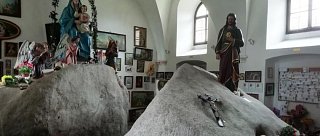Pilgrimage Site Svatý Kámen – Church of Our Lady of the Snow
Southeast of the village of Rychnov nad Malší, on a gentle hill along the road to Tichá, stands the pilgrimage church dedicated to Our Lady of the Snows at Svatý Kámen (Holy Stone).
The 1.5 km path from Rychnov is lined with six Baroque pilgrimage chapels, renovated in 1993. Originally, a larger number of such chapels were built along various approaches to the site, but only a few have survived to the present day.
The origin of the pilgrimage site Svatý Kámen dates back to the first half of the 16th century. According to legend, around 1500, the Virgin Mary of the Snows appeared on a large boulder to some young shepherds near Rychnov, surrounded by heavenly light and accompanied by angels. The angels were said to have split the stone into two parts, which have since continued to separate. When a hay cart can pass between them, it is believed the end of the world will come.
Stories of the miraculous stone and the apparition of the Virgin Mary led to the establishment of the pilgrimage site in the 17th century. The site gained many devotees, who donated significant financial and material gifts to the church. In 1778, the relics of the virgin martyr Saint Concordia were placed in the church in a decorated glass coffin. However, they were later transferred to the parish church in Bavorov.
The pilgrimage site was founded by the Poor Clares of Český Krumlov, who owned the land including Rychnov nad Malší. Abbess Kristina Pöperlová had a simple chapel built over the sacred boulder in 1653. Due to the growing number of pilgrims, the chapel soon proved too small, and a larger Baroque pilgrimage church was constructed, dedicated to Our Lady of the Snows. The single-nave Baroque church features a presbytery with a three-sided termination and a prismatic tower over the western facade. A square sacristy is attached to the eastern side of the presbytery. On the northern side of the nave lies the original three-sided chapel housing the sacred stone. On the stone stands a wooden statue of the Virgin Mary holding the infant Jesus, surrounded by angels. These statues were restored in 1991 by academic painter and restorer Prof. Malthauser from Příbram. The interior of the church features a false barrel vault with lunettes, preserving remnants of original paintings and stucco decorations. The Baroque furnishings did not survive—many were destroyed or stolen in the 1950s.
Also part of the pilgrimage site is a hexagonal chapel from 1706, built over a spring of healing water. It stands near the western side of the church. Its interior is decorated with original stonework from light granite. The original entrance grilles were lost (stolen in the 1970s) and have since been replaced with replicas.
The construction of the church extended into the first half of the 18th century. Financing was supported by Princess Marie Ernestina of Eggenberg. Alongside the church, a small monastery was constructed on the eastern side, consisting of three cloister wings, an enclosed courtyard (paradise garden), and a simple one-story residential building with monks’ cells.
The reforms of Emperor Joseph II negatively affected the site. In 1782, the Poor Clares convent in Český Krumlov was dissolved, and the pilgrimage church at Svatý Kámen, which belonged to the order, was closed. After reopening, the spiritual administration passed to the Cistercians of Vyšší Brod. From 1801, the patronage rights were held by the Schwarzenberg family, who acquired the property after the Poor Clares were dissolved. Around 1840, the Redemptorists took over the administration, replaced in 1895 by the Congregation of the Brothers of the Blessed Sacrament (Petrini) from České Budějovice. The Redemptorists returned in 1924 and oversaw the site until 1949, when the church and monastery were closed. The last pilgrimage took place in 1948. During the event, the priest who was celebrating the pilgrimage mass was to be arrested by the secret police. He was warned in time and escaped over the border into Austria after the sermon.
The church and monastery complex at Svatý Kámen, including agricultural buildings, was gradually devastated from the 1950s onward—first by the state farms, which used the site as storage and granaries, and later by the border guard forces. The barracks were abolished in the mid-1990s, and the building was sold for use by the Red Cross. The church was used to store barbed wire and fencing materials for military obstacles, and the tower was converted into an observation post. Stucco, paintings, and carvings inside the church were used as target practice by soldiers.
The Baroque furnishings were destroyed or stolen in the 1950s. Only the organ was preserved and moved to the church in Rudolfov near České Budějovice. The monastery buildings—including the cloisters and living quarters—were demolished in the 1970s and 1980s. Before that, the agricultural buildings opposite the church had also been demolished. During the 1980s, the complete demolition of the church was seriously considered.
However, 1989 brought change. With the opening of the borders came the revival of the Marian pilgrimage site at Svatý Kámen. Restoration began with funding from the Czechoslovak Ministry of the Interior, Austria, Germany, and private donations from former local residents. It was completed in 1993, and the church—including the chapel with the healing spring—was solemnly reconsecrated.
In August 1991, the first renewed pilgrimage took place. A decorated horse-drawn cart carried the restored statue of the Virgin Mary—previously housed in the Church of St. Giles in Dolní Dvořiště—in an international procession.

